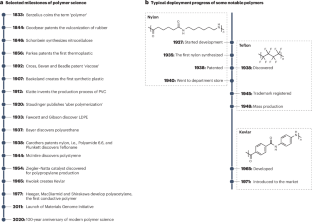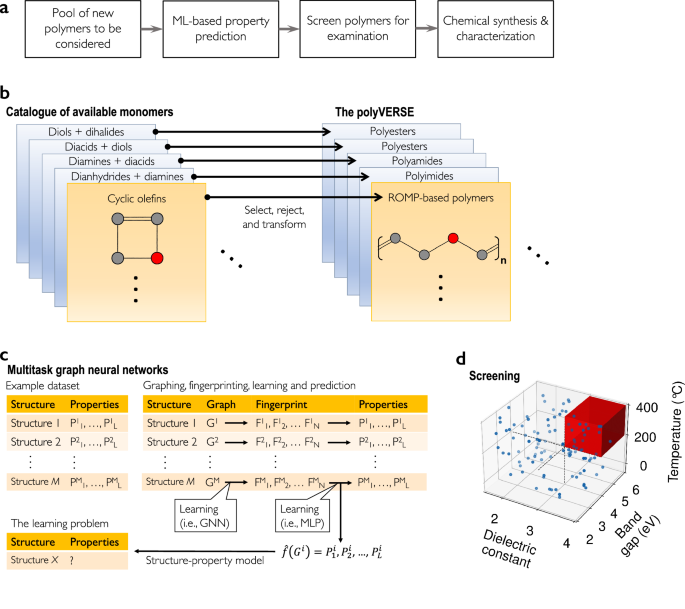2024-08-19 ジョージア工科大学
<関連情報>
- https://research.gatech.edu/using-ai-find-polymers-future
- https://www.nature.com/articles/s41578-024-00708-8
- https://www.nature.com/articles/s41467-024-50413-x
人工知能が支援する機能的で持続可能なポリマーの設計 Design of functional and sustainable polymers assisted by artificial intelligence
Huan Tran,Rishi Gurnani,Chiho Kim,Ghanshyam Pilania,Ha-Kyung Kwon,Ryan P. Lively & Rampi Ramprasad
Nature Reviews Materials Published:19 August 2024
DOI:https://doi.org/10.1038/s41578-024-00708-8

Abstract
Artificial intelligence (AI)-based methods continue to make inroads into accelerated materials design and development. Here, we review AI-enabled advances made in the subfield of polymer informatics, with a particular focus on the design of application-specific practical polymeric materials. We consider exemplar design attempts within a few critical and emerging application spaces, including materials designs for storing, producing and conserving energy, and those that can prepare us for a sustainable economy powered by recyclable and/or biodegradable polymers. AI-powered workflows help to efficiently search the staggeringly large chemical and configurational space of materials, using modern machine-learning (ML) algorithms to solve ‘forward’ and ‘inverse’ materials design problems. A theme explored throughout this Review is a practical informatics-based design protocol that involves creating a set of application-specific target property criteria, building ML model predictors for those relevant target properties, enumerating or generating a tangible population of viable polymers, and selecting candidates that meet design recommendations. The protocol is demonstrated for several energy- and sustainability-related applications. Finally, we offer our outlook on the lingering obstacles that must be overcome to achieve widespread adoption of informatics-driven protocols in industrial-scale materials development.
AIによるエネルギー貯蔵用高温誘電体の発見 AI-assisted discovery of high-temperature dielectrics for energy storage
Rishi Gurnani,Stuti Shukla,Deepak Kamal,Chao Wu,Jing Hao,Christopher Kuenneth,Pritish Aklujkar,Ashish Khomane,Robert Daniels,Ajinkya A. Deshmukh,Yang Cao,Gregory Sotzing & Rampi Ramprasad
Nature Communications Published:19 August 2024
DOI:https://doi.org/10.1038/s41578-024-00708-8

Abstract
Electrostatic capacitors play a crucial role as energy storage devices in modern electrical systems. Energy density, the figure of merit for electrostatic capacitors, is primarily determined by the choice of dielectric material. Most industry-grade polymer dielectrics are flexible polyolefins or rigid aromatics, possessing high energy density or high thermal stability, but not both. Here, we employ artificial intelligence (AI), established polymer chemistry, and molecular engineering to discover a suite of dielectrics in the polynorbornene and polyimide families. Many of the discovered dielectrics exhibit high thermal stability and high energy density over a broad temperature range. One such dielectric displays an energy density of 8.3 J cc−1 at 200 °C, a value 11 × that of any commercially available polymer dielectric at this temperature. We also evaluate pathways to further enhance the polynorbornene and polyimide families, enabling these capacitors to perform well in demanding applications (e.g., aerospace) while being environmentally sustainable. These findings expand the potential applications of electrostatic capacitors within the 85–200 °C temperature range, at which there is presently no good commercial solution. More broadly, this research demonstrates the impact of AI on chemical structure generation and property prediction, highlighting the potential for materials design advancement beyond electrostatic capacitors.



